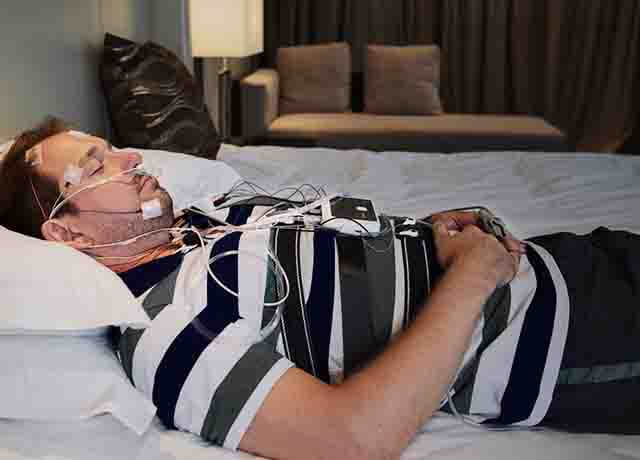When you find you have some signs which are related to sleep apnea, you need to contact your GP or family doctor first. And your doctor may refer you to a sleep specialist at a sleep clinic. The specialist may recommend you schedule a sleep test to track your nighttime habits and diagnose any sleep disorders.
There are two accepted methods of objective testing, in-laboratory polysomnography (PSG) and home testing with portable monitors.
Polysomnography
Nighttime in-laboratory Level 1 polysomnography (PSG) is the gold standard test for diagnosis. Patients are monitored with electroencephalogram (EEG) leads, pulse oximetry, temperature and pressure sensors.[1]
Home Sleep Test with Portable Monitors
Your doctor might provide you with simplified tests to be used at home to diagnose sleep apnea. Portable monitoring devices should, at a minimum, record airflow, respiratory effort, and blood oxygenation. [2]
Three Questions of having sleep study in sleep lab that you may concern about
-Can I bring my bedtime items during sleep study in sleep lab?
If you're having a sleep study in a sleep center, you'll arrive in the evening and stay overnight. You can bring items you use for your bedtime routine, and you can sleep in your own nightclothes. The room where polysomnography is done is similar to a hotel room, and it's dark and quiet during the test.
-Will I get tangled in the wire because I move around in bed unconsciously?
After you get ready for bed, sleep specialist will place sensors on your body. The sensors are connected by wires to a computer, but the wires are long enough to let you move around in bed.
-Can I go to the bathroom in the middle of the night?
Polysomnography technologists monitor you throughout the night. The sleeping area will have a low-light video camera and an audio system, so they can talk to you and hear you from their monitoring area outside the room. So don’t worry, they can come into the room to free up the wires if you need to get up during the night.
The process of Home Sleep Testing
You can have the sleep test at home with a portable device if your sleep specialist allows.
If you're having a home sleep apnea test, you should follow your regular bedtime schedule, place the sensors on your body and turn on the machine according to the instructions. Don't worry about your doctor not having access to your sleep data. Your doctor may ask you to keep a sleep log. And in the morning, you remove the sensors when you wake. You'll return the testing equipment to your doctor's office or by mail.
References:
1.Jennifer M. Slowik, Jacob F. Collen (2020). "Obstructive Sleep Apnea". StatPearls. PMID 29083619.
2.Epstein L J , D Kristo, Jr S P , et al. Clinical guideline for the evaluation, management and long-term care of obstructive sleep apnea in adults.[J]. Journal of Clinical Sleep Medicine Jcsm Official Publication of the American Academy of Sleep Medicine, 2009, 5(3):263.

